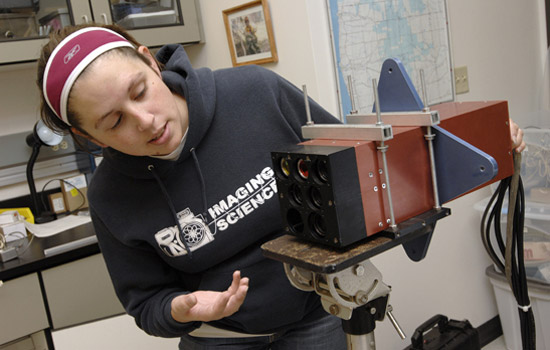Scientists peer through frozen ‘cooling lake’ to gauge energy production
A. Sue Weisler
Imaging science graduate student May Arsenovic is working with professor Carl Salvaggio and a team of research scientists to study the power production at a plant in Midland, Mich., using an airborne sensor similar to the one shown above. Arsenovic and senior scientist Bob Kremens will collect ground data in Midland throughout the winter.
Once a week, starting in November and running through April, a small plane will fly overhead in Midland, Mich., taking images of a frozen lake attached to a power plant. RIT graduate student May Arsenovic will travel to Midland throughout the winter to verify the ground data.
Arsenovic, a doctoral candidate in the Chester F. Carlson Center for Imaging Science, is working with CIS professor Carl Salvaggio, and a team of research faculty to study the frozen cooling lake for the U.S. Department of Energy’s Savannah River National Laboratory.
The DOE-funded project, worth $949,971, will develop technology to monitor energy production at power plants in some foreign countries.
The cooling lake in Midland was picked because it is the only one in the United States that freezes. It is much bigger than it needs to be to cool the power plant and, as a result, the amount of hot water discharged into the lake cannot warm the entire body of water in the winter. The overcapacity of the cooling lake harkens to discarded plans to build a nuclear facility at the site. Public outcry led to the construction of a smaller gas-powered plant instead.
Studying the frozen cooling lake poses many challenges for Salvaggio’s team as it seeks to remotely gather information obscured by a layer of ice and snow. The scientists are interested in the thermal turbulence that takes place when the hot-water discharge mixes with the cold water in the lake. The melt hole created as the hot water pours into the lake is their main source for deducing the power levels produced at the site.
“The research aspect of this project will investigate how ice acts as an insulator and determine how much energy is kept inside the lake because there’s an ice layer over it,” Salvaggio says.
His team will measure the temperature of the hot water with thermal infrared imagery. The scientists will also calculate the thickness and insulating capacity of the snow and ice with passive microwave remote sensing—which has a longer wavelength than infrared.
Salvaggio and Arsenovic will double check the accuracy of their remote measurements by measuring the ice thickness on the ground using a combination of ultrasound techniques and temperature profiles of the ice, water and air column at fine spatial increments.












